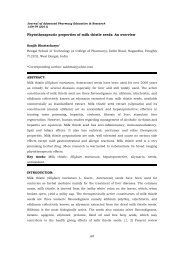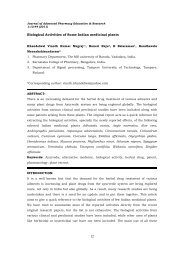Formulation Development and Evaluation of Aceclofenac ... - japer
Formulation Development and Evaluation of Aceclofenac ... - japer
Formulation Development and Evaluation of Aceclofenac ... - japer
Create successful ePaper yourself
Turn your PDF publications into a flip-book with our unique Google optimized e-Paper software.
weight size <strong>of</strong> formulation to % total weight <strong>of</strong><br />
chitosan microspheres. [7]<br />
Drug Entrapment<br />
The various formulations <strong>of</strong> the chitosan<br />
microspheres were subjected for drug content.<br />
50 mg <strong>of</strong> chitosan microspheres from all batches<br />
were accurately weighed <strong>and</strong> crushed. The<br />
powdered <strong>of</strong> microspheres were dissolved with<br />
10ml ethanol in 100ml volumetric flask <strong>and</strong><br />
makeup the volume with 0.1 N HCl. This resulting<br />
solution is than filtered through whatmann filter<br />
paper No. 44. After filtration, from this solution<br />
10 ml was taken out <strong>and</strong> diluted up to 100 ml<br />
with 0.1 N HCl. Again from this solution 2 ml was<br />
taken out <strong>and</strong> diluted up to 10 m1 with 0.1 N HCI<br />
<strong>and</strong> the absorbance was measured at 275 nm<br />
against 0.1 N HCI as a blank. The percentage<br />
drug entrapment was calculated as follows. [8]<br />
Calculated drug concentration<br />
% Drug entrapment = x 100<br />
Theoretical drug concentration<br />
Shape <strong>and</strong> Surface Characterization <strong>of</strong><br />
Chitosan Microspheres by Scanning Electron<br />
Microscopy<br />
Bhavya Rastogi, et al.: <strong>Formulation</strong> <strong>Development</strong> <strong>and</strong> <strong>Evaluation</strong> <strong>of</strong> Acecl<strong>of</strong>enac Chitosan Microspheres<br />
From the formulated batches <strong>of</strong> chitosan<br />
microspheres, formulation (F4) which showed an<br />
appropriate balance between the buoyancy <strong>and</strong><br />
the percentage release were examined for<br />
surface morphology <strong>and</strong> shape using scanning<br />
electron microscope Hitachi, Japan, Trichy.<br />
Sample was fixed on carbon tape <strong>and</strong> fine gold<br />
sputtering was applied in a high vacuum<br />
evaporator. The acceleration voltage was set at<br />
20KV during scanning. Microphotographs were<br />
taken on different magnification <strong>and</strong> higher<br />
magnification (200X) was used for surface<br />
morphology. [9]<br />
In vitro Release Studies:<br />
The drug release rate from chitosan micro<br />
spheres was carried out using the USP<br />
dissolution paddle assembly. A weighed amount<br />
<strong>of</strong> micro spheres equivalent to 100 mg drug were<br />
dispersed in 900 ml <strong>of</strong> phosphate buffer 6.8<br />
maintained at 37 ± 0.5°C <strong>and</strong> stirred at 100 RPM.<br />
At preselected time intervals one ml sample was<br />
withdrawn <strong>and</strong> replaced with equal amount <strong>of</strong><br />
phosphate buffer 6.8. The collected samples<br />
were suitably diluted with phosphate buffer 6.8<br />
<strong>and</strong> analyzed spectrophotometrically at 275 nm<br />
to determine the concentration <strong>of</strong> drug present in<br />
the dissolution medium. The dissolution studies<br />
were repeated using phosphate buffer pH 6.8 as<br />
dissolution medium. [10]<br />
In-Vivo Anti - Inflammatory Study<br />
It has been reported in the literatures that<br />
acecl<strong>of</strong>enac may have therapeutic potential as<br />
anti-inflammatory agent either alone or in<br />
combination with nonsteroidal anti-<br />
inflammatory drug. Therefore the in-vivo<br />
500µg/kg <strong>of</strong> formulation release behaviour <strong>of</strong> the<br />
best formulation F4 was studied by measuring<br />
anti-inflammatory activity in adult male wistar<br />
rats using cotton pellet granuloma method. The<br />
male wistar rats were divided in to three groups,<br />
each group consisting <strong>of</strong> 6 animals. One group<br />
served as control, second group served as<br />
st<strong>and</strong>ard, received 500µg/kg <strong>of</strong> acecl<strong>of</strong>enac as<br />
solution in water in two divided dose orally,<br />
while third group received chitosan<br />
microspheres containing acecl<strong>of</strong>enac orally<br />
require to release about 500µg/kg <strong>of</strong><br />
acecl<strong>of</strong>enac) once daily during the experiment.<br />
The rats with an average weight <strong>of</strong> 150g were<br />
anaesthetized with ether. The cotton pellets each<br />
Journal <strong>of</strong> Advanced Pharmacy Education & Research Oct-Dec 2012 Vol 2 Issue 4<br />
217





